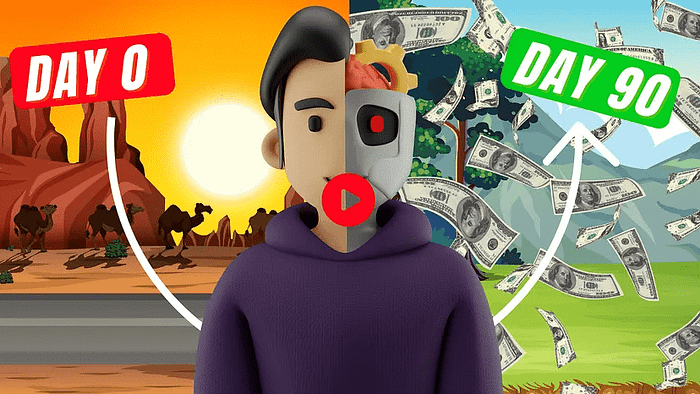In today’s digital age, creating compelling social media content has become an indispensable tool for businesses and individuals alike. With billions of active users across various platforms, the potential for reaching a massive audience is immense. However, crafting engaging and viral-worthy social media content can be a daunting task, especially when working with a limited budget. In this article, we’ll explore effective strategies and techniques that will help you create captivating social media content without breaking the bank. By understanding your audience, leveraging user-generated content, and utilizing simple yet powerful tools, you can maximize your reach and engagement on social media.
We strongly recommend that you check out our guide on how to take advantage of AI in today’s passive income economy.
Table of Contents
Understanding Your Audience: The Key to Crafting Relevant Social Media Content
The first step in creating viral-worthy social media content is to have a deep understanding of your target audience. Knowing their interests, preferences, and pain points will help you tailor your content to resonate with them effectively. Conduct thorough research to gather insights about your audience’s demographics, psychographics, and online behavior. Utilize social media analytics tools to identify the type of content that performs well within your niche and analyze the engagement metrics of your competitors. By gaining a clear picture of your audience, you can create social media content that not only captures their attention but also encourages them to share it with their network.
To further enhance the relevance of your social media content, consider segmenting your audience based on specific criteria such as age, location, or interests. This approach allows you to deliver highly targeted content that speaks directly to each segment’s unique needs and preferences. For example, if you’re a fashion brand targeting millennials, you can create social media content that showcases trendy outfits and accessories while using language and visuals that appeal to this age group. By providing value and addressing the specific interests of your audience segments, you increase the likelihood of your content being shared and going viral.
Leveraging User-Generated Content: Harnessing the Power of Your Community
One of the most cost-effective ways to create viral-worthy social media content is by leveraging user-generated content (UGC). UGC refers to any form of content, such as photos, videos, or reviews, created by your followers and customers. Encouraging your audience to share their experiences and creations related to your brand not only provides you with a wealth of authentic content but also fosters a sense of community and engagement. Implement hashtag campaigns, contests, or challenges that incentivize your followers to participate and showcase their creativity. By featuring UGC on your social media channels, you demonstrate your appreciation for your community and create a sense of belonging that can lead to increased brand loyalty and advocacy.
When incorporating UGC into your social media content strategy, it’s essential to obtain permission from the original creators and give them proper credit. This not only shows respect for their work but also encourages others to participate in future campaigns. Additionally, curating and showcasing the best UGC can help you maintain a consistent brand image and ensure that the content aligns with your overall messaging. By leveraging UGC, you can create a steady stream of authentic and engaging social media content without the need for a large production budget.
Storytelling: Crafting Compelling Narratives That Resonate with Your Audience
In the realm of social media content, storytelling is a powerful tool for capturing attention and evoking emotions. People are naturally drawn to stories that they can relate to or find inspiring. By weaving compelling narratives into your social media content, you can create a deeper connection with your audience and increase the chances of your content being shared. Focus on crafting stories that align with your brand’s values, mission, and the interests of your target audience. Share real-life experiences, customer success stories, or behind-the-scenes glimpses into your business to humanize your brand and make it more relatable.
When crafting your stories, consider the format that best suits your narrative and the platform you’re using. Short-form video content, such as Instagram Stories or TikTok videos, is particularly effective for telling concise and engaging stories. Utilize a mix of visuals, text, and music to create an immersive experience that captures your audience’s attention from the very first frame. Ensure that your stories have a clear beginning, middle, and end, and include a call-to-action that encourages viewers to engage with your brand further. By mastering the art of storytelling, you can create social media content that not only entertains but also leaves a lasting impact on your audience.
Repurposing and Cross-Promoting Your Social Media Content
Creating original social media content on a consistent basis can be time-consuming and resource-intensive. However, by repurposing and cross-promoting your content across multiple platforms, you can maximize its reach and engagement without starting from scratch each time. Identify your best-performing social media content and explore ways to adapt it for different platforms. For example, a blog post can be transformed into a series of informative tweets, an engaging video, or an eye-catching infographic. By presenting your content in various formats, you cater to the preferences of different audience segments and increase the likelihood of your message being consumed and shared.
In addition to repurposing your content, cross-promoting it across your social media channels can significantly amplify its reach. When you publish a piece of content on one platform, make sure to share it on your other social media profiles, along with a compelling caption and relevant hashtags. This approach not only exposes your content to a wider audience but also encourages your followers to connect with you on multiple platforms. Furthermore, collaborating with influencers or complementary brands for cross-promotion can help you tap into new audiences and expand your reach even further.
Utilizing Simple Yet Powerful Tools for Creating Engaging Visuals
Visuals play a crucial role in creating viral-worthy social media content. Eye-catching images, graphics, and videos can stop scrollers in their tracks and entice them to engage with your content. However, creating professional-looking visuals doesn’t necessarily require expensive software or a large budget. There are numerous user-friendly and affordable tools available that can help you design stunning visuals for your social media content. Canva, for example, offers a wide range of templates, stock images, and design elements that you can customize to align with your brand’s aesthetic. Other tools like Adobe Spark, Piktochart, and Animoto provide intuitive interfaces for creating graphics, infographics, and short videos.
When designing your visuals, keep in mind the specific requirements and best practices for each social media platform. For instance, square images tend to perform well on Instagram, while horizontal images are better suited for Twitter and Facebook. Ensure that your visuals are high-quality, visually appealing, and consistent with your brand’s color scheme and typography. Incorporate relevant text overlays, captions, or calls-to-action to provide context and encourage engagement. By leveraging simple yet powerful design tools, you can create visuals that enhance the impact of your social media content and increase its shareability.
Measuring Success and Refining Your Social Media Content Strategy
Creating viral-worthy social media content is an iterative process that requires continuous monitoring, analysis, and optimization. To gauge the success of your content and identify areas for improvement, it’s essential to track key performance indicators (KPIs) relevant to your goals. These may include metrics such as reach, engagement rate, shares, click-through rate, and conversions. Utilize the analytics tools provided by each social media platform to gain insights into how your content is performing and which pieces resonated most with your audience.
Based on these insights, refine your social media content strategy to focus on the types of content that generate the highest levels of engagement and achieve your desired objectives. Continuously test different formats, themes, and posting times to identify what works best for your audience. Engage with your followers by responding to comments, messages, and mentions to foster a sense of community and encourage further interaction. By regularly analyzing your performance and making data-driven decisions, you can optimize your social media content strategy for maximum impact and virality.
Conclusion
Creating viral-worthy social media content on a budget is achievable by understanding your audience, leveraging user-generated content, crafting compelling stories, repurposing and cross-promoting your content, utilizing simple design tools, and continuously measuring and refining your strategy. By implementing these techniques and staying authentic to your brand’s voice and values, you can create social media content that resonates with your audience, sparks engagement, and has the potential to go viral. Remember, virality is not always predictable, but by consistently delivering value and engaging with your community, you increase the chances of your content being shared and reaching a wider audience. Embrace the power of social media content and watch your brand’s online presence soar to new heights.
FAQ:
What is social media content?
Social media content refers to any form of media, such as text, images, videos, or audio, that is created and shared on social media platforms. This content is designed to engage, inform, entertain, or promote a brand, product, or idea to a target audience. Social media content can be created by businesses, organizations, influencers, or individual users and is tailored to the specific platform and audience it is intended for.
What kind of content is on social media?
Social media platforms host a wide variety of content types, including:
- Text posts, such as status updates, tweets, or captions
- Images, including photos, graphics, infographics, and memes
- Videos, ranging from short-form content like TikTok or Instagram Reels to longer-form content on YouTube or IGTV
- Live streams, such as Instagram Live, Facebook Live, or Twitch streams
- Stories, which are short-lived, ephemeral content that disappears after 24 hours
- Audio content, such as podcasts or Clubhouse discussions
- Interactive content, like polls, quizzes, or Q&A sessions
What are the three types of social media content?
While there are numerous ways to categorize social media content, three main types are:
- Owned content: This refers to content created and published by a brand or individual on their own social media channels. Examples include blog posts, product photos, or brand videos.
- Earned content: This type of content is created by users or influencers and mentions or features a brand. Examples include user-generated content, product reviews, or influencer partnerships.
- Paid content: Paid content involves promoting content through sponsored posts, ads, or influencer collaborations. This type of content is designed to reach a wider audience beyond a brand’s existing followers.
What content should I make on social media?
The type of content you create on social media should align with your brand’s goals, target audience, and the platforms you’re using. Here are some ideas:
- Educational content that provides value to your audience, such as how-to guides, tips, or industry insights
- Entertaining content that engages and delights your followers, like memes, humor, or behind-the-scenes glimpses
- Inspirational content that motivates or encourages your audience, such as quotes, success stories, or personal anecdotes
- Promotional content that showcases your products or services, including product demos, customer testimonials, or special offers
- Interactive content that encourages audience participation, such as polls, contests, or Q&A sessions
- Timely content that capitalizes on current events, trending topics, or holidays relevant to your niche
Remember to maintain a balance between promotional and non-promotional content, focusing on providing value to your audience while staying true to your brand’s voice and aesthetic.

We strongly recommend that you check out our guide on how to take advantage of AI in today’s passive income economy.




